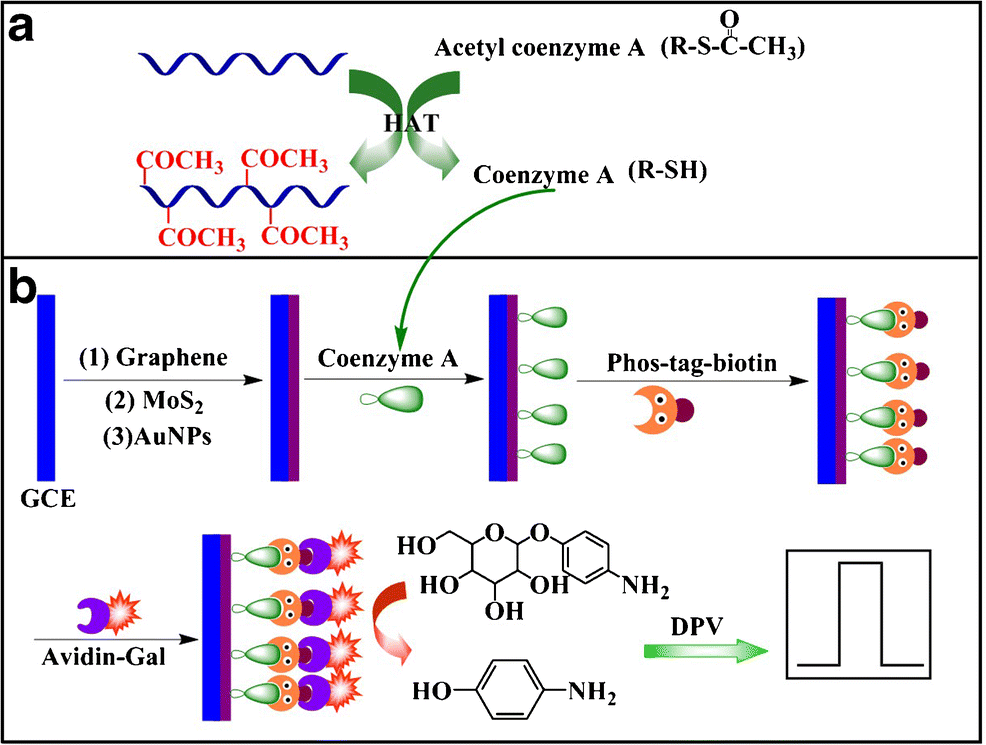当前位置:
X-MOL 学术
›
Microchim. Acta
›
论文详情
Our official English website, www.x-mol.net, welcomes your
feedback! (Note: you will need to create a separate account there.)
Photoelectrochemical determination of the activity of histone acetyltransferase and inhibitor screening by using MoS2 nanosheets
Microchimica Acta ( IF 5.3 ) Pub Date : 2019-08-31 , DOI: 10.1007/s00604-019-3756-3 Huanshun Yin , Hanwen Wu , Yan Chen , Fei Li , Jun Wang , Shiyun Ai
Microchimica Acta ( IF 5.3 ) Pub Date : 2019-08-31 , DOI: 10.1007/s00604-019-3756-3 Huanshun Yin , Hanwen Wu , Yan Chen , Fei Li , Jun Wang , Shiyun Ai

|
The enzyme histone acetyltransferase (HAT) catalyzes the acetylation of a substrate peptide, and acetyl coenzyme A is converted to coenzyme A (CoA). A photoelectrochemical method is described for the determination of the HAT activity by using exfoliated MoS2 nanosheets, phos-tag-biotin, and β-galactosidase (β-Gal) based signal amplification. The MoS2 nanosheets are employed as the photoactive material, graphene nanosheets as electron transfer promoter, gold nanoparticles as recognition and capture reagent for CoA, and phos-tag-biotin as the reagent to link CoA and β-Gal. The enzyme β-Gal catalyzes the hydrolysis of substrate O-galactosyl-4-aminophenol to generate free 4-aminophenol which is a photoelectrochemical electron donor. The photocurrent increases with the activity of HAT. Under optimal conditions, the response is linear in the 0.3 to 100 nM activity range, and the detection limit is 0.14 nM (at S/N = 3). The assay was applied to HAT inhibitor screening, specifically for the inhibitors C646 and anacardic acid. The IC50 values are 0.28 and 39 μM, respectively. The method is deemed to be a promising tool for epigenetic research and HAT-targeted cancer drug discovery. Graphical abstract Histone acetyltransferase was detected using a sensitive photoelectrochemical method using MoS2 nanosheets as photoactive material. Histone acetyltransferase was detected using a sensitive photoelectrochemical method using MoS2 nanosheets as photoactive material.
中文翻译:

使用二硫化钼纳米片进行组蛋白乙酰转移酶活性的光电化学测定和抑制剂筛选
酶组蛋白乙酰转移酶 (HAT) 催化底物肽的乙酰化,乙酰辅酶 A 转化为辅酶 A (CoA)。描述了一种光电化学方法,通过使用剥落的 MoS2 纳米片、phos-tag-生物素和基于 β-半乳糖苷酶 (β-Gal) 的信号放大来测定 HAT 活性。MoS2 纳米片用作光活性材料,石墨烯纳米片用作电子转移促进剂,金纳米颗粒用作 CoA 的识别和捕获试剂,以及 phos-tag-生物素作为连接 CoA 和 β-Gal 的试剂。酶 β-Gal 催化底物 O-半乳糖基-4-氨基苯酚的水解,生成游离的 4-氨基苯酚,这是一种光电化学电子供体。光电流随着 HAT 的活性而增加。在最佳条件下,响应在 0 处是线性的。3 至 100 nM 活性范围,检测限为 0.14 nM(S/N = 3)。该测定应用于 HAT 抑制剂筛选,特别是抑制剂 C646 和漆树酸。IC50 值分别为 0.28 和 39 μM。该方法被认为是表观遗传研究和 HAT 靶向癌症药物发现的有前途的工具。图形摘要 组蛋白乙酰转移酶使用敏感的光电化学方法检测,使用二硫化钼纳米片作为光活性材料。使用二硫化钼纳米片作为光活性材料,使用灵敏的光电化学方法检测组蛋白乙酰转移酶。该方法被认为是表观遗传研究和 HAT 靶向癌症药物发现的有前途的工具。图形摘要 组蛋白乙酰转移酶使用敏感的光电化学方法检测,使用二硫化钼纳米片作为光活性材料。使用二硫化钼纳米片作为光活性材料,使用灵敏的光电化学方法检测组蛋白乙酰转移酶。该方法被认为是表观遗传研究和 HAT 靶向癌症药物发现的有前途的工具。图形摘要 组蛋白乙酰转移酶使用敏感的光电化学方法检测,使用二硫化钼纳米片作为光活性材料。使用二硫化钼纳米片作为光活性材料,使用灵敏的光电化学方法检测组蛋白乙酰转移酶。
更新日期:2019-08-31
中文翻译:

使用二硫化钼纳米片进行组蛋白乙酰转移酶活性的光电化学测定和抑制剂筛选
酶组蛋白乙酰转移酶 (HAT) 催化底物肽的乙酰化,乙酰辅酶 A 转化为辅酶 A (CoA)。描述了一种光电化学方法,通过使用剥落的 MoS2 纳米片、phos-tag-生物素和基于 β-半乳糖苷酶 (β-Gal) 的信号放大来测定 HAT 活性。MoS2 纳米片用作光活性材料,石墨烯纳米片用作电子转移促进剂,金纳米颗粒用作 CoA 的识别和捕获试剂,以及 phos-tag-生物素作为连接 CoA 和 β-Gal 的试剂。酶 β-Gal 催化底物 O-半乳糖基-4-氨基苯酚的水解,生成游离的 4-氨基苯酚,这是一种光电化学电子供体。光电流随着 HAT 的活性而增加。在最佳条件下,响应在 0 处是线性的。3 至 100 nM 活性范围,检测限为 0.14 nM(S/N = 3)。该测定应用于 HAT 抑制剂筛选,特别是抑制剂 C646 和漆树酸。IC50 值分别为 0.28 和 39 μM。该方法被认为是表观遗传研究和 HAT 靶向癌症药物发现的有前途的工具。图形摘要 组蛋白乙酰转移酶使用敏感的光电化学方法检测,使用二硫化钼纳米片作为光活性材料。使用二硫化钼纳米片作为光活性材料,使用灵敏的光电化学方法检测组蛋白乙酰转移酶。该方法被认为是表观遗传研究和 HAT 靶向癌症药物发现的有前途的工具。图形摘要 组蛋白乙酰转移酶使用敏感的光电化学方法检测,使用二硫化钼纳米片作为光活性材料。使用二硫化钼纳米片作为光活性材料,使用灵敏的光电化学方法检测组蛋白乙酰转移酶。该方法被认为是表观遗传研究和 HAT 靶向癌症药物发现的有前途的工具。图形摘要 组蛋白乙酰转移酶使用敏感的光电化学方法检测,使用二硫化钼纳米片作为光活性材料。使用二硫化钼纳米片作为光活性材料,使用灵敏的光电化学方法检测组蛋白乙酰转移酶。


















































 京公网安备 11010802027423号
京公网安备 11010802027423号